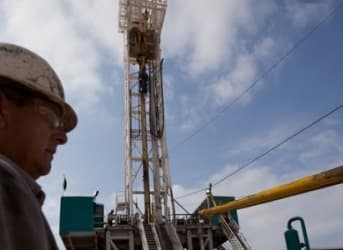Increased oil output in the US has kept World oil output from declining over the past few years and a major question is how long this can continue. Poor estimates by both the US Energy Information Administration (EIA) and the Railroad Commission of Texas (RRC) for Texas state wide crude plus condensate (C+C) output make it difficult to predict when a sustained decline in US output will begin.
About 80 to 85% of Texas (TX) C+C output is from the Permian basin and the Eagle Ford play, so estimating output from these two formations is crucial. I have used data from the production data query (PDQ) at the RRC to find the percentage of TX C+C output from the Permian (about 44% in Feb 2015) and Eagle Ford plays (40% in Feb 2015).
Dean’s estimates of Texas C+C output are excellent in my opinion and are close to EIA estimates through August 2014. I used EIA data for TX C+C output through August 2014 and Dean’s best estimate from Sept 2014 to Feb 2015. By multiplying the % of C+C output from the RRC data with the combined EIA and Dean’s estimate, I was able to estimate Eagle Ford and Permian output. The chart below shows this output in kb/d.

The following chart shows the combined Permian and Eagle Ford output from 2012 to 2015 in kb/d, this chart is not zero scaled. Related: Big Hit For U.S. Oil Production In January

Below I have created a few scenarios for the Bakken and Eagle Ford. This analysis is based on the pioneering work by Rune Likvern at the Oil Drum (Red Queen series) and his blog at Fractional Flow, any errors in analysis are mine. I doubt that Mr. Likvern would speculate beyond 2 years forward in time (or he has not done so in the past). The data gathered from the North Dakota Industrial Commission (NDIC) by Enno Peters was also instrumental in the Bakken/Three Forks model.
My reason for speculating beyond this is simply to see what the eventual resource recovery would be if the assumptions of the model hold true in the future. Needless to say, this is unlikely to be correct, any predictions beyond 2018 are highly speculative.
For the Bakken Scenario
OPEX=$4/b
Other costs= $4/b
Real Discount rate=7%
Transport cost= $12/b
Well Cost=$8 million
Royalties+Taxes=26.5%
Natural gas sales of about $3/b are used to offset OPEX and other costs. All costs in real 2015$. Related: A Plot To Hold Down Oil Prices Or Just A Happy Coincidence?
Oil prices are shown on the right hand scale. The average new well estimated ultimate recovery (EUR) rises from 350 kb in Jan 2013 to 430 kb in Dec 2014 and then gradually decreases starting in June 2015 reaching an annual rate of decrease of 7% in June 2016. New wells are added at a rate of 120 wells per month from March 2015 to June 2023 and decrease to zero by May 2028. Total wells drilled are about 25,300. Chart with Scenario below (real oil price and the number of new wells added each month on right axis).
Click Image To Enlarge
Eagle Ford scenario has the same assumptions as the Bakken scenario except for the following assumptions.
Other Costs= $2/b
Transport Cost= $3/b
Well Cost $7 million.
It is assumed higher associated gas sales are used to reduce other costs and better access to pipelines and refineries reduces transport cost. Related: Tesla Could Be Changing The Dynamics Of Global Energy
Note that David Hughes estimates about 7.8 Gb in Drilling Deeper from the Eagle Ford.
ADVERTISEMENT

In the Chart below the two scenarios are combined, ERR is about 14 Gb through 2030.

If the Permian Basin is able to remain on plateau and other US output remains relatively flat, then US output may remain on a plateau until 2017 if oil prices rise from $50/b today by about a 4.7% annual rate. I believe such a price scenario is relatively conservative.
This is a guest post by Dennis Coyne for Peakoilbarrel
More Top Reads From Oilprice.com:
- How The Majors Are Playing The Oil Price Slump
- Oil, The Fed And The Ugly Truth About Capital Markets
- Oil Price War May Benefit Both US Shale And Saudi Arabia



















http://peakoilbarrel.com/eagle-ford-permian-basin-and-bakken-and-eagle-for-scenarios/
I am happy to answer questions there.
Dennis Coyne